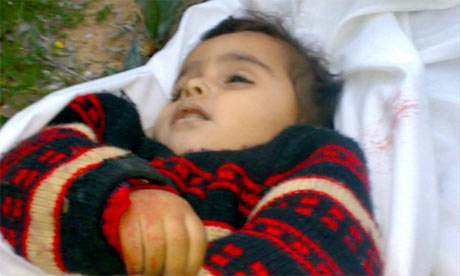guardian.co.uk 23 January 2009

Amal Abed Rabbo, two, photographed by her family after she died in an Israeli attack outside her house in the village of Izbit Abed Rabbo, Gaza, on 7 January 2009
Amira Qirm lay on a hospital bed today with her right leg in plaster, and held together by a line of steel pins dug deep into her skin. For several days after her operation Amira, 15, was unable to speak, and even now talks only in a low whisper.
In her past are bitter memories: watching her father die in the street outside their home, then hearing another shell land and kill her brother Ala'a, 14, and her sister Ismat, 16, and then the three days that she spent alone, injured and semi-conscious, trying to stay alive in a neighbour's abandoned house before she could be rescued last Sunday.
Ahead of her, she has a long recovery. First there is an imminent flight to France for the best possible medical treatment, many more operations and then months of rehabilitation and psychiatric care.
Only now, after most of the dead have been buried, is the first properly researched reckoning of the toll emerging. What already stands out is the striking cost borne by the children of Gaza, who make up more than half of the 1.5 million people living in this overcrowded strip of land.
The Palestinian death toll after three weeks of Israel's war was 1,285, according to the Palestinian Centre for Human Rights, or 1,268, according to the al-Mezan Human Rights Centre. Among those dead were at least 280 children.
The impact will be felt by many more for years to come. Among the more than 4,000 people injured more than a quarter were children, some left with severe disabilities. The Gaza Community Health Programme estimates that half Gaza's children – around 350,000 – will develop some form of post-traumatic stress disorder.
Amira Qirm, who lived in Tel al-Hawa, the scene of some of the heaviest fighting in Gaza City, is among the few in line to receive medical treatment abroad. Already she has a dream to fulfil once she returns to Gaza. "I want to be a lawyer," she said today , "and to stand in court facing the Israelis for what they have done."
Most of the other children will have to make do with treatment in Gaza. Last week some psychologists were walking through the ruins of a house in Atatra, talking to a boy from the Abu Halima family who had lost his father, three brothers and an infant sister in a horrific fire after an Israeli phosphorus shell hit the house.
"The problem is they are not feeling safe even in their own homes, on the streets, in the mosques," said Ehassan Afifi, the psychologist. "This boy is seeing what happened as if it is an endless movie. The physically affected can be operated on, sometimes cured. But these mental problems may lead to problems for the rest of their lives."
******************
Eyad al-Sarraj, a prominent psychiatrist who leads the Gaza community health programme, said that years of violence in Gaza had only fostered radicalism among its young people, who have seen their fathers humiliated and now left defenceless. His organisation is training 1,000 people to spread out across Gaza to offer help with grief and mourning and to pass serious cases on to professional therapists.
Already there were reports, he said, of children bed-wetting, stuttering, falling mute, having trouble sleeping, becoming violent or restless and losing their appetites. The difference between this war and the uprisings, like the first intifada of the late 1980s, was that whereas there was once a frontline, with tanks near the border, now the bombing and artillery reached deep inside Gaza's urban areas and into the homes of ordinary families....